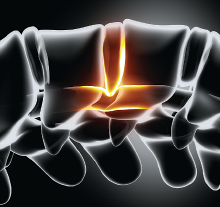Depression Increases Risk of Stroke, Heart Disease in African Americans
African Americans with symptoms of major depressive disorder may be at an increased risk of developing stroke and coronary heart disease compared with those without depression, according to a study published in Circulation: Quality and Outcomes.
The researchers used data collected as part of the Jackson Heart Study (a community-based study of African Americans in Jackson, Miss.). The study included 3,178 participants aged 21 to 94, who were screened for depressive symptoms at study initiation and followed up annually over a 10-year period to assess any development of stroke or coronary heart disease. Participants had no history of cardiovascular disease prior to the study.
The researchers found that participants who displayed major depressive symptoms (in accordance with the Center for Epidemiological Studies Depression score) had twice the risk of stroke compared with those without depressive symptoms, after adjusting for behavioral risk factors, antidepressant use, and patient-reported coping strategies. Similar associations were observed for coronary heart disease in models adjusted for behavioral and clinical risk factors, but associations were not significant after adjustment for coping strategies.
“The need for greater understanding of associations between depressive symptoms and cardiovascular outcomes in African Americans is particularly important in light of reported racial disparity in disease severity, timely diagnosis, and use of drug therapy,” said lead author Emily O’Brien, Ph.D., a medical instructor at the Clinical Research Institute at Duke University.
O’Brien E, Greiner M, Sims M, et al. Depressive Symptoms and Risk of Cardiovascular Events in Blacks: Findings From the Jackson Heart Study.
Circ Cardiovasc Qual Outcomes. 2015;8(6):552-559.
Bullies May Be at Increased Risk of Eating Disorders
Previous studies have found that victims of childhood bullying are at a heightened risk of developing anxiety, depression, and eating disorders. Now, a study published in the December issue of the International Journal of Eating Disorders has found that bullies are nearly twice as likely to display symptoms of bulimia compared with children who are not involved with bullying.
After interviewing and assessing 1,420 youth aged 9 to 25, the researchers divided the participants into four categories according to bullying involvement: not involved, bully only, victim only, or both bully and victim.
The researchers found that 30.8 percent of bullies report symptoms of bulimia compared with 17.6 percent of children not involved in bullying. Children who were both bullies and victims had the highest prevalence of anorexia symptoms (22.8 percent compared with 5.6 percent of the children not involved in bullying) and binge eating (4.8 percent of children compared with less than 1 percent of uninvolved children).
The findings also revealed that children who were victims of bullying had nearly twice the risk of displaying symptoms of anorexia (11.2 percent prevalence compared with 5.6 percent of children who were not involved in bullying) and bulimia (27.9 percent prevalence compared with 17.6 percent of children not involved in bullying).
Copeland W, Bulik C, Zucker N, et al. Does Childhood Bullying Predict Eating Disorder Symptoms? A Prospective, Longitudinal Analysis.
Int J Eat Disord. 2015;48(8): 1141-1149.
Teens, Parents Support Restricting Access to E-Cigarettes
Even as the number of youth using electronic cigarettes (e-cigarettes) continues to grow, both teens and their parents feel stricter rules should be in place to restrict their use.
This was the take-home message from the C.S. Mott Children’s Hospital National Poll on Children’s Health conducted by researchers from the University of Michigan.
The survey was administered in September to a randomly selected, stratified group of parents with at least one child aged 13 to 18 (n=1,517); among a subset of these parents, their teens also responded to teen-focused questions (n=636).
According to the study’s findings, 80 percent of parents and teens support laws that restrict the use of e-cigarettes in public spaces; more than 90 percent of parents and 87 percent of teens thought that all states should implement laws restricting sales of e-cigarettes to people under age 18; and over 90 percent of parents and teens believe e-cigarettes should feature health warnings similar to those on traditional cigarettes.
“The strong level of agreement between parents and teens suggests that both groups are concerned about the health hazards of e-cigarettes,” said Matthew Davis, M.D., M.A.P.P., director of the National Poll on Children’s Health and a professor of pediatrics and internal medicine in the Child Health Evaluation and Research Unit of the University of Michigan’s C.S. Mott Children’s Hospital.
Reducing Psychiatric Services in County Increases Number Seen in Emergency Department
Countywide reductions in psychiatric services increased the number of visits and length of stay for patients undergoing psychiatric consultation in emergency departments (ED) within that community, according to a study in the Annals of Emergency Medicine.
Researchers from the University of California, Davis, School of Medicine conducted a study evaluating the effect of Sacramento County’s decision in October 2009 to reduce inpatient psychiatric beds at the county mental health treatment center from 100 to 50 and close the facility’s outpatient unit at a university hospital adjacent to the health center.
Electronic health record data were collected for ED visits for the eight months before the decrease in county services (October 2008 to May 2009) and the eight months after the decrease (October 2009 to May 2010).
Results showed that the number of daily psychiatric consultations in the ED increased from 1.3 (prior to inpatient bed reduction and outpatient unit closure) to 4.4 (after reduction and closure). Average ED length of stay for psychiatry consultation patients increased from 14.1 hours to 21.9 hours.
“This phenomenon has important implications for future policy to address the challenges of caring for patients with psychiatric needs in our communities,” the study authors wrote.
Nesper A, Morris B, Scher L, et al. Effect of Decreasing County Mental Health Services on the Emergency Department.
Ann Emerg Med. Nov. 3, 2015. pii: S0196-0644(15)01270-6.
Circadian Disruptions May Lead to Memory Loss
Chemical changes brought on by circadian disruptions such as jet lag may play a key role in the memory loss associated with Alzheimer’s disease (AD), reports a new study in the Journal of Alzheimer’s Disease.
To examine the connection between circadian problems and memory, a team at the University of California, Irvine, altered the light/dark cycle of mice predisposed to develop Alzheimer’s. The Alzheimer’s mice had greater learning impairments when subjected to the altered sleep schedule compared with normal mice and Alzheimer’s mice not exposed to the altered light/dark cycle.
Follow-up showed that the altered light/dark schedule induced a decrease of the antioxidant glutathione in the brain cells, but the glutathione levels were much lower in Alzheimer’s mice compared with normal mice. The researchers speculated that people at risk for Alzheimer’s might have lower glutathione levels, which may increase the risk of oxidative damage to brain cells following altered sleep patterns.
They suggested that clinicians and caregivers should consider emphasizing good sleep habits to people with elevated Alzheimer’s risk or mild cognitive impairment.
LeVault K, Tischkau S, Brewer G. Circadian Disruption Reveals a Correlation of an Oxidative GSH/GSSG Redox Shift With Learning and Impaired Memory in an Alzheimer’s Disease Mouse Model.
J Alzheimers Dis. Oct 9, 2015. [Epub ahead of print]
Mechanism Reveals Relationship Between Motivation, Recovery From Nerve Damage
Motivation is known to facilitate recovery following nerve damage, such as from a stroke or spinal cord injury, but it was unknown how motivation affects a patient’s recovery of motor function in rehabilitation.
A study published in Science suggests that the nucleus accumbens—the brain’s motivation center—activates brain regions involved in motor recovery.
Researchers in Japan used animal models of nerve damage to track the flow of activity from the nucleus accumbens to the sensorimotor cortex during recovery. When the researchers pharmacologically blocked the activity of the nucleus accumbens one month after the injury, motor recovery subsequently decreased. However, recovery was not affected if the nucleus accumbens was blocked three months after injury, suggesting the region exerts its effect early in the recovery process.
The researchers believe these findings demonstrate the critical importance of providing psychological support early in the recovery of patients who have suffered nerve damage to maximize their potential gains. ■
Sawada M, Kato K, Kunieda T, et al. Function of the Nucleus Accumbens in Motor Control During Recovery After Spinal Cord Injury.
Science. Oct 2, 2015;350(6256):98-101.






